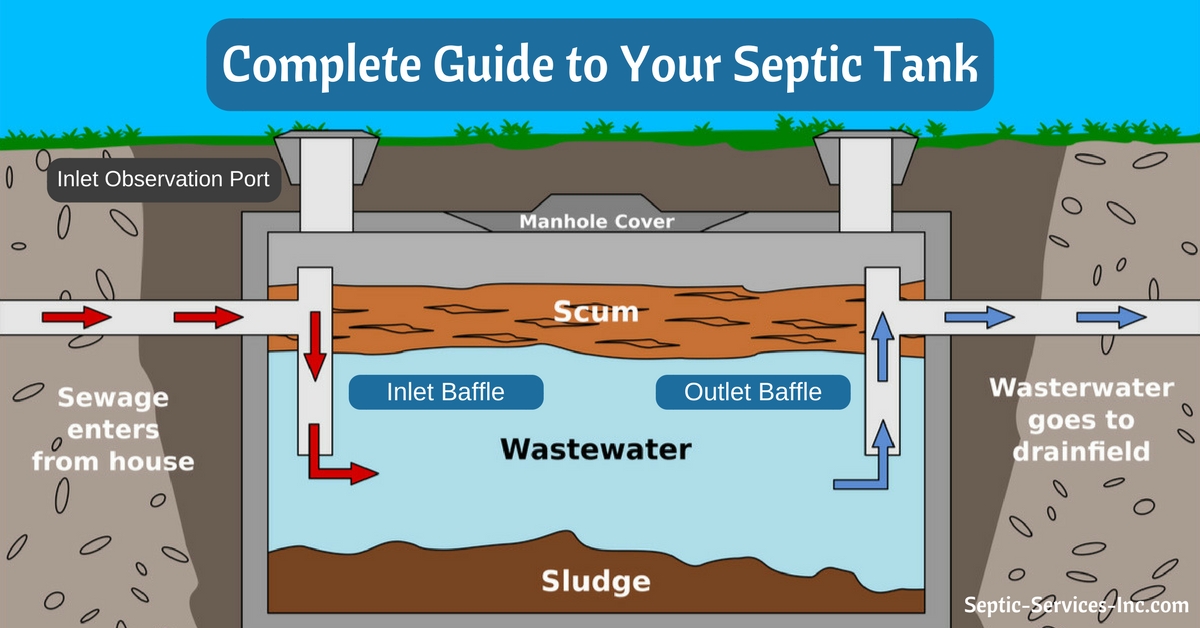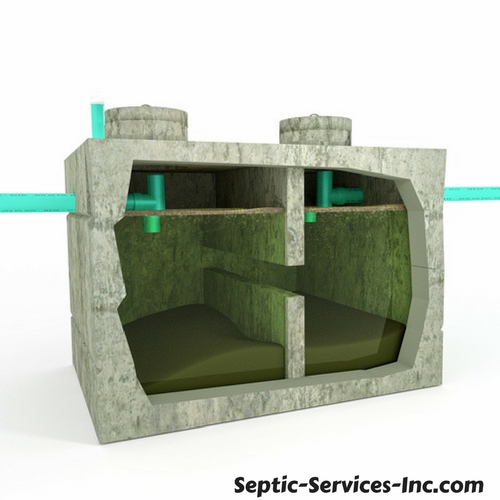When it comes to septic systems the septic drain field (also called leach field) it can remain a mystery to many people. Unlike the tank a drain field typically has no markers. The drain field tends to go unnoticed until there is a problem. This is a shame since the drain field is the most expensive component of a septic system. Understanding your leach field can help increase the longevity of your septic system and save you a lot of money. Once you take a look at how a basic drain field works we can see how problems can arise.
Would you like to feel much more comfortable about owning and maintaining your septic system? Check out our ebook below. It is filled with in depth knowledge on all things septic, yet is easily skimmable.
Drain Field Layout
A typical drain field has three main components: good soil, aggregate, and perforated pipe. A drainfield works through a simple process. The perforated pipe receives the effluent (waste from the septic tank) and distributes it among the aggregate and as it trickles through the aggregate the soil receives the effluent. The soil will filter out the harmful bacteria and reintroduce it back to the water table.
When the septic tank is done breaking down the waste it spills over to the drain field. The effluent is distributed evenly through perforated pipes. Perforated pipes are pipes that have holes close to the bottom. The perforated pipes run the length of the drain field and as the as the effluent fills the pipes it spills out evenly the length of the field. Once the effluent leaves the pipe it enters into the aggregate.
Aggregate is made of stone and in some pressure dose systems a layer of stone and sand underneath. The purpose of the aggregate is to evenly disperse the effluent so that there is equal absorption in the soil. The effluent trickles through the stone and spreads itself evenly on top of the soil. If the soil underneath the stone becomes saturated the stone aggregate will begin to fill up. This is why an inspector will stick a probe rod into the aggregate. If the effluent level goes up to or beyond the stone aggregate, there is no more usable soil on the sides or bottom of the drain field. This is why it is so important to have good soil.
The soil is the foundation to a functioning drain field. When you install a septic system the first step is to have a septic system designer and a health department representative come out and run tests. Much of these tests are looking at your soil; seeing what it is comprised of and how it drains. If you have sandy soil it is going to drain well. Other soils that are more clay-like will not drain as well and may require a larger drain field to compensate for lack of good drainage. These tests involve digging test pits and running a percolation test (or “perc” test).
Now that we know how a drain field works we can take a look at what can go wrong in a field.
Drain Field Problems
When you see spots of thick,lime green grass starting to grow above your drain field that means that it is malfunctioning. But, how did it get there? It is all about the soil. As the soil begins to be filled up of effluent and sludge the capacity of the soil decreases and the effluent begins to seep out of the ground.
The best way to understand this is to think of the drain field as a sponge. As a sponge fills up it fills all the spaces in the sponge. In a drain field that void space gets filled in with sludge over time and it loses its ability to hold as much water. The liquid then moves upward since it has no place to go.
A drainfield can also be affected by too much water entering into the system. To go back to the sponge analogy. If you keep filling a sponge with water it will hold it until it has time to drain or dry out. In the same way if a leach field is receiving more water than it should it will not be able to keep up with excess wastewater and will eventually spill out on the ground. Not only that, but the soils can be permanently damaged. This means that the system may never go back to the way it was before it received the excess flows.
This is why it is so important to make sure that you are not using more water than you need and there is no excess water exiting your home into your septic system. Some major problems would be a well back-flushing too often or a sump pump directed into the sewer line. Sump pumps can be particularly dangerous. If you have excessive rainfall much of that rain is falling on your drain field plus the sump pump is adding extra water from the basement. Several heavy rainfalls could cause permanent damage to your system. You should look for any leaky faucets or toilets regularly and check to make sure your condensate line from your air conditioning unit is not entering the sewer line. Even a small trickle like this will cause damage down the road.
One other way to damage a drain field is by compacting soils. This is done with constant driving over a field or by having large construction vehicles running across the field. How does this affect the drain field? It comes down to the much needed void space in the drain field. As the soils compact they lose the ability to hold any wastewater and the field becomes useless. Heavy construction trucks have enough weight to crush the pipes in the field as well. This creates a blockage in the field that reduces its drainage area. It is very beneficial to know where your drain field is located exactly, if you are planning to drive near the field. The same goes with construction. Let your builders know that the field is forbidden to drive on. Large construction vehicles have enough weight to ruin your field. If you don’t know where your field is located you can have your pumper find it during regular maintenance or ask an inspector to come out and find it for you.
Locating Your Drain Field
As a homeowner, it is in your benefit to know where your drain field is located. If you have a septic inspection done before you buy your house see if they can show where the drain field is in the report. Our reports will have a picture of where the drain field is located. There are a few reasons why this helps you maintain your septic system.
- As stated above, you should make sure no one is driving over your drain field. This goes for construction as well.
- Many homeowners want to plant trees. Trees can be very damaging to a drain field. We will talk about this later on.
- You want to make sure that no excess water is pouring over your drain field. Any rainwater from a roof leader or excess runoff can damage a system over time.
- As part of regular maintenance, a good pumper will probe your field to let you know how much moisture is in it now.
- It is good to look for any signs of malfunctioning. If the drain field starts to look like there are patches of heavy bright green grass, then there is a good chance that sewage is coming out of the field.
Drain Fields and Trees
Another major factor in the health of your septic system is tree growth. Without knowing where your field is many times people will plant trees on top of the system or very close by. When we do inspections this can be a red flag. The main concern is the roots that grow into the field. You might think that this will help the drainage, but it does just the opposite. The tree roots will enter into the pipes and form a “root ball.” This is a collection of fine root hairs that clog up the pipe. The sludge then gets caught in the hairs and creates a watertight seal. This stops the pipe from directing the waste throughout the system. Inevitably, the area before the stoppage receives all of the liquid and starts to saturate. Trees can damage the life-expectancy of a drain field because you are not using the field to its full capacity. Its best to remove all trees near any septic system within a 10 foot radius. If you are planting a tree make sure you know where your drain field is located. The farther the tree is planted away from any component of a septic system the better.
Hopefully, by now the drain field is a little bit less of a mystery to you. There is still plenty to learn about your particular drain field and how to maintain it. We will keep posting information about drain fields and how you can maintain yours.
In the meantime, check out our ebook, it will prepare you to deal with any issue as a septic system owner.







